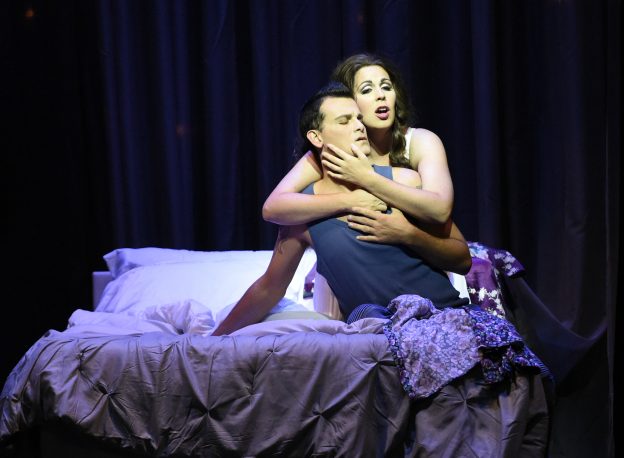
Star-Advertiser Review – Hawaii Opera Theatre’s ‘Romeo & Juliet’ hurtles headlong toward tragedy
“Romeo & Juliet” is a timeless love story, but it is also a cautionary tale: Love can transcend hate, but when we are mired in partisanship, when we focus on “our side” winning, we lose what is more important — our children, our souls and ultimately, our future.
Whether we have seen the opera, read Shakespeare or watched “West Side Story,” we all know how this story turns out. What makes Hawaii Opera Theatre’s production of Charles Gounod’s “Romeo & Juliet” that opened Friday at the Blaisdell Concert Hall so exciting is that it celebrates the love story in all its glory while highlighting its message.
That message was conveyed primarily through the production’s effective staging and striking visual design, which used anachronisms to convey timelessness.
Costumes distinguished between the wealthy red-tie Capulets (Juliet’s family) and the working-class blue-tie Montagues (Romeo’s family). Singers wore suits and little black cocktail dresses but also carried swords and cell phones. Juliet has a nurse and a coming-out party, but she and her girlfriends take selfies and buy negligees.
In HOT’s telling, Romeo and Juliet are victims, and their families’ feud centers on their fathers, who lead the opening wake for their children, introduce the bedroom scene and, in the end, depart together in mutual loss.
Director Brad Dalton’s program notes explained why “the pace is brisk” in this production, and conductor Emmanuel Plasson kept to that on opening night, at times leaving the singers’ breathless but conveying a sense of hurtling headlong, without pause or thought, toward tragedy.
Orchestra, chorus and singers throughout were strong. Gounod created too many roles to be covered adequately in a review, but suffice to say that even the secondary roles were delightful. Be sure to notice Alyssa Martin’s delightful bravado as the young boy Stephano; the lively Blythe Kelsey as Juliet’s nurse; Carlos Enrique Santelli as Tybalt, his high, edgy tenor an apt rival for Romeo; Erik Haines’ climatic lecture on justice as the Duke; the solemnly sonorous Jaime Offenbach as Friar Laurent arguing for peace and love; and the vocally rich Leon Williams as Juliet’s father, Lord Capulet.
Amanda Woodbury is stunning as Juliet, showing great dynamic control and coloratura. She has a large and flexible voice, with the lightness and clarity of youth but the warmth of passionate love. Her Act I “Je veux vivre” was great but she was even better in Act II.
Derek Taylor is a handsome Romeo, and his spinto tenor has the tensile strength to convey tragedy. Rather than matching Juliet’s warmth, his voice is more a foil to highlight hers. His more reserved vocal tone was at its best in the anguish of Act II and as an equal to Tybalt, despite their class differences.
As Romeo’s best friend Mercutio, Brian James Myer was the evening’s delightful surprise. He’s a dynamite performer, with a large, vibrant baritone and energetic acting. His “Queen Mab” aria sparkled, and he became the natural focus of every scene he entered.
Stage action flowed around two symmetrically arranged structures of square framing that suggest multistoried buildings of every and no particular era. Scenes are created in plain view with minimal touches, such as party lights and confetti, a cross for the church, a curtain for a bedroom, while a full backdrop signaled ambience through color — party pink, midnight blue, the falling black of tragedy.
Scenes change via carefully staged “freeze frames” of the action that are held during transition music before quietly melting away into the next scene, a powerful technique that created indelible moments. And staging juxtaposes the feuding families with communal loss: separated groups facing off in anger versus everyone coming together in mourning.
As “Romeo & Juliet” so eloquently argues, hatred as “the cradle of love” ends in tragedy for all, and its closing line is as pertinent today as ever: “Lord, forgive us.”
Ruth O. Bingham received her doctorate in musicology from Cornell University and has been reviewing the musical arts for more than 30 years.
